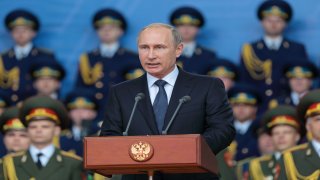The Soviet Invasion of Afghanistan Should Guide Our Approach to Russia
Beyond expressing their commitment to Ukraine’s sovereignty, officials must present Ukrainian victory as the main end goal.
Since Russia began its full-fledged invasion of Ukraine in 2022, the United States and its allies have provided historic levels of assistance to Kyiv, implemented the most extensive network of sanctions ever levied on a country, and rallied the global community to oppose the Kremlin’s aggression at the United Nations and other international bodies. However, despite the laudable strength of this response, the United States has struggled to state the overall objective of its assistance to Kyiv clearly.
Although the Biden administration has been correct to say the terms and circumstances of any negotiations should be up to Ukraine, the primary goal of U.S. assistance—often articulated by President Volodymyr Zelenskyy and other Ukrainian officials—must be laid out by the United States for allies and foes alike: The withdrawal of Russian troops from all occupied Ukrainian territory. Stating this clearly and frequently would not be an unprecedented step. During the Soviet Union’s invasion of Afghanistan (1979–1989), a strength of the U.S. response was the consistency of its primary objective across three presidential administrations: The USSR had to withdraw its troops from all occupied Afghan territory.
In December 1979, when the Soviet Union first invaded and installed a communist leader in Kabul, President Jimmy Carter authorized military aid to Afghan rebels and demanded the Kremlin withdraw all of its forces from Afghanistan. Throughout the 1980s, President Ronald Reagan expanded military assistance and repeatedly pledged U.S. commitment to opposing Soviet aggression until there was a complete withdrawal of Soviet troops.
Even in February 1989, while the last Soviet soldiers were departing from Afghanistan, President George H.W. Bush refused to commit to ending U.S. assistance to Afghan rebels who opposed the Soviet-backed government. Despite different global outlooks and foreign policies, Presidents Carter, Reagan, and Bush firmly maintained that U.S. assistance would continue until there were no Soviet soldiers left in Afghanistan. This strategy ultimately convinced Soviet leadership that its position in Afghanistan was untenable.
The clarity that defined U.S. policy toward the Soviet invasion of Afghanistan hasn’t been found in today’s approach toward Russia. Over the past two years, U.S. cabinet members have offered vague and shifting policy objectives. In April 2022, Secretary of Defense Lloyd Austin said America’s goal was for Ukraine to win and prevent Russia from launching more invasions. In contrast, in a May 2022 New York Times op-ed, President Joe Biden defined the U.S. policy objective as ensuring Ukraine could “deter and defend itself against further aggression.”
A year later, top-line objectives have remained unclear. In March 2023, during the second Summit for Democracy, Secretary of State Antony Blinken expressed support for Zelenskyy’s Peace Formula—which includes the withdrawal of Russian soldiers from Ukraine’s territory—but in his remarks only emphasized that peace must be “just and durable.” In June 2023, during a lengthy speech in Helsinki, Blinken reiterated U.S. support for Ukraine’s defense of its sovereignty and noted assistance would last “as long as it takes,” but stopped short of directly expressing support for Ukraine’s victory.
In contrast to these statements, when Secretary of State George Schultz was asked in 1985 about the possibility of a negotiated settlement to the invasion of Afghanistan, he stated unequivocally: “The principal thing is addressing the problem of Soviet troops in Afghanistan and their withdrawal. It’s the key.” Three years later, as part of a United Nations-brokered withdrawal agreement, Schultz reiterated that a Soviet exit was “essential” to U.S. support for a political settlement. This same level of policy coherency and steadfastness is necessary today.
Like in many other armed conflicts, having a bold and clearly stated objective does not require precise knowledge of how the desired end state will come about. Throughout the 1980s, U.S. officials did not expect the Soviet Union to complete an orderly, staged withdrawal from Afghanistan by the end of the decade, followed less than three years later by the USSR’s collapse. Indeed, even when Soviet forces staged successful offensives, and it appeared that Afghan resistance could be snuffed out, U.S. officials continued to demand a complete Soviet withdrawal and support Afghan partisans. Today, beyond expressing their commitment to Ukraine’s sovereignty, officials must present Ukrainian victory as the main end goal.
By clearly stating that the presence of Russian troops within Ukraine’s borders will remain unacceptable, the United States will improve the perception of its commitment to Ukraine and hopefully—over time—sow doubt in the Kremlin about Russia’s prospects for success. Crucially, when the policy goal is made clear, it will be more easily discernible whether U.S. and allied actions are living up to the main objective they are pursuing.
Artur Kalandarov is an analyst currently studying at Stanford University’s Center for Russian, East European, and Eurasian Studies. He has previously been published in The Hill, Newsweek, The National Interest, Defense Post, and Small Wars Journal.
Image: ID1974 / Shutterstock.com

